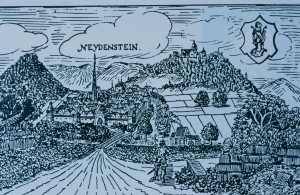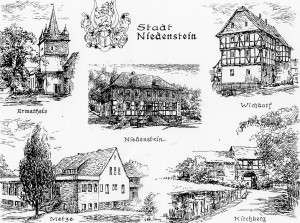
Niedenstein is a lovely town which today is made up of 5 districts: Niedenstein, Ermetheis, Metze and Kirchberg.
Historically the Knatz family lived in what is today the Niedenstein District which was within the walls of the original city. Niedenstein district has about 1500 residents today, with about 6000 inhabitants within all 5 districts. The town is situated in the Northern part of the state of Hesse, the northernmost part of the Schwalm-Eder-Kreis in the Kurhessischen Bergland. Kassel, a city today known for it’s culture and Art is nearby.
Historically, Niedenstein is located in what was the Landgraviate of Hesse which was a land area under a count who had feudal duty to the Holy Roman Empire. A landgraviate could consist of a considerable amount of Territory and was ruled by the Landgrave. The term Landgrave continued in use after the fall of the Roman Empire. In the early Middle Ages Hesse had been part of the Landgraviate of Thuringia but following the war of Thuringian Succession, the area was inherited by the son of Sophie of Thuringia, Duchess of Brabant. Henry I, Landgrave of Hesse became the first Landgrave of Hesse in 1246.
The Landgraviate of Hesse existed as a unit from 1264 to 1657 when it was divided between the sons of Philip I, Landgrave of Hesse. The Landgraviate rose to importance under Philip I Landgrave of Hesse, who was also called Philip the Magnanimous. Philip embraced Protestantism in 1524 and took steps to create an alliance with other protestant princes
Upon the death of Philip I in 1567, the Landgraviate was divided between his sons from his first marriage into 4 Landgraviates of which one was the Landgraviate of Hesse-Kassell (or Hesse-Cassel). In 1803 the area became the Electorate of Hesse under William IX who was elevated to Imperial Elector and who ruled until Napoleon took over in 1806. When Napoleon was defeated in 1813, the Electorate was restored. From 1813 on, the Electorate of Hesse-Cassel was a separate country and became part of the German Confederation in 1815. William’s grandson, Elector Frederick William picked the losing side in the Austro-Prussian war and Hesse-Kassel was annexed into Prussia in 1866 and remained part of Prussia until 1944. This is why immigrants from this area often list their origin as Prussia and not Germany. In 1945-46, the area became part of the US Occupation Zone. From 1946, the area was reorganized into the state of Hesse in the Federal Republic of Germany.)
In 1954, the town of Niedenstein celebrated its 700th birthday with the publication of Niedensteiner Heimatbuch (a local history of Niedenstein). Portions of the Heimatbuch have been translated for me by Gerda Haffner
In the year 1254 and 1259, the castle and town of Niedenstein were first mentioned so the town comes from the century in which most Hessian towns were created. There is some general information provided but there are no documents earlier than 1200’s. There is a prehistoric settlement on the hill above Niedenstein which is known as Die Altenburg. The Heimatbuch mentions fairs that were held every year, one in June and one in November. These were important events because on that day there would be no taxes and the merchants would be able to offer their goods free of tax.
Konrad vonElben has his residence in the castle Niedenstein. But the exact location of the castle is not known. Konrad was determined to found a town in this area called “Mark Wichdorf.” After Konrad’s death, the first time the name Niedenstein is mentioned is in the year 1322 by Margrave Otto von Hessen and his son Heinrich. It can only be concluded that they called it Niedenstein because it was “lying underneath the stone.” It could also mean “beneath the rock.”
In the surroundings of Niedenstein were 4 locations (Schwosbach, Elmshagen, Wichdorf and Niedernhausen. All these places were mentioned in the 15th century as settlements that were left by their inhabitants and given up. It can already be concluded that from these settlements Niedenstein got her status as a city. The two oldest citizens’ that were mentioned in Niedenstein in 1276 are Konrad von Elgerhausen and Konrad von Mederich.
There was a church in Niedenstein which burned down around 1490 but it was rebuilt by the monks of St. Mary Monastery. This church was changed in 1526 to an Evangelisch Lutheran church and then in 1607 to an Evangelisch-Reformed church. This church was standing until the 30 years war when it was burned down. In 1654, a new church was built which was replaced in 1777 by the present church. The church books begin in 1653. When the church burned down in the 30 years war, all records prior to 1653 were probably burned too. Note that a Knatz appears on the first page of the church books in 1654 but a Knatz is not listed as a resident of Niedenstein in the list of residents in the Heimatbuch for the 1600’s. The plat map from 1600’s in the Marburg Archive shows Paulus Knatz as a landowner.
Niedenstein was affected greatly by the 30 year’s war. The description of what remained from the Heimatbuch is heart-breaking:
“At the end of year 1648 when the Bells of Muenster finally sounded the peach in the country, 14 houses were left and 4 persons living. That is to say 99 persons of the inhabitants that were living there in 1620 were dead, had fled or were somewhere perished. Ashes were covering all dwelling places and the 14 buildings could hardly be used. No church, no town hall, no school. All fields were damaged and could not be toiled. And yet our town did not die completely. Gradually people recovered and returned and after a few years we had a census and we had again 27 men, 8 widows, living in 28 houses. One hundred years after the great war, we could finally count again 76 households and the whole damage lasted into the 18th century especially as the seven years war, the French overran the county and the development of the town stopped again. It took 200 hundred years for the final damage of the 30 years was to be overcome. In 1820, our town had 82 households and the number of people from 1620 was nearly reached again. In 1855, we had 707 souls, 132 families and 106 dwellings.”
“As a result of the Seven Year’s War (when Frederick the Great fought Teresa of Austria, 1756-1763), Prussia took over the area that included Niedenstein. The reunion of Hesse with Prussia could not be accepted by many so it was a strong incentive for emigration. In the 1750’s emigration from Niedenstein started mostly for economic reasons as people sought a better life in a foreign land. In 1750, there are 78 houses that have to pay their contribution (tax) and 4 dwelling lots that were not built on yet. In the buildings lived 76 men, 85 women, 101 sons, 79 daughters, 2 farm hands, 8 farm girls, all together 351 christian people. Also 7 jews, 6 women, 16 sons, 12 daughters, 1 farm hand, 3 farm girls, altogether 45 jews. Among the artisans and those in commerce (“dealers”), there were 2 bakers, 7 tailors, 4 shoemakers, 6 builders, 3 linen weavers, 1 saddler, 1 carpenter, 1 leatherworker, 1 miller, and 1 schoolmaster. Now the day laborers, 9 day laborers, 11 female day laborers, 6 jews, 1 mayor, 1 tax collector, 1 schoolmaster, 1 organist and 2 shepherds. Among the dealers (merchants), the jews were the strong majority.”
The town of Niedenstein from 1856 to 1866, gave up 160 of it’s people to America. There was hardly one family in the town that did not send one of several members to America. Usually the connection to this emigrants were lost but in the case of the Knatz family, letters from Niedenstein were saved and passed down to me (Geraldine Knatz) which allowed me to make that connection again.

